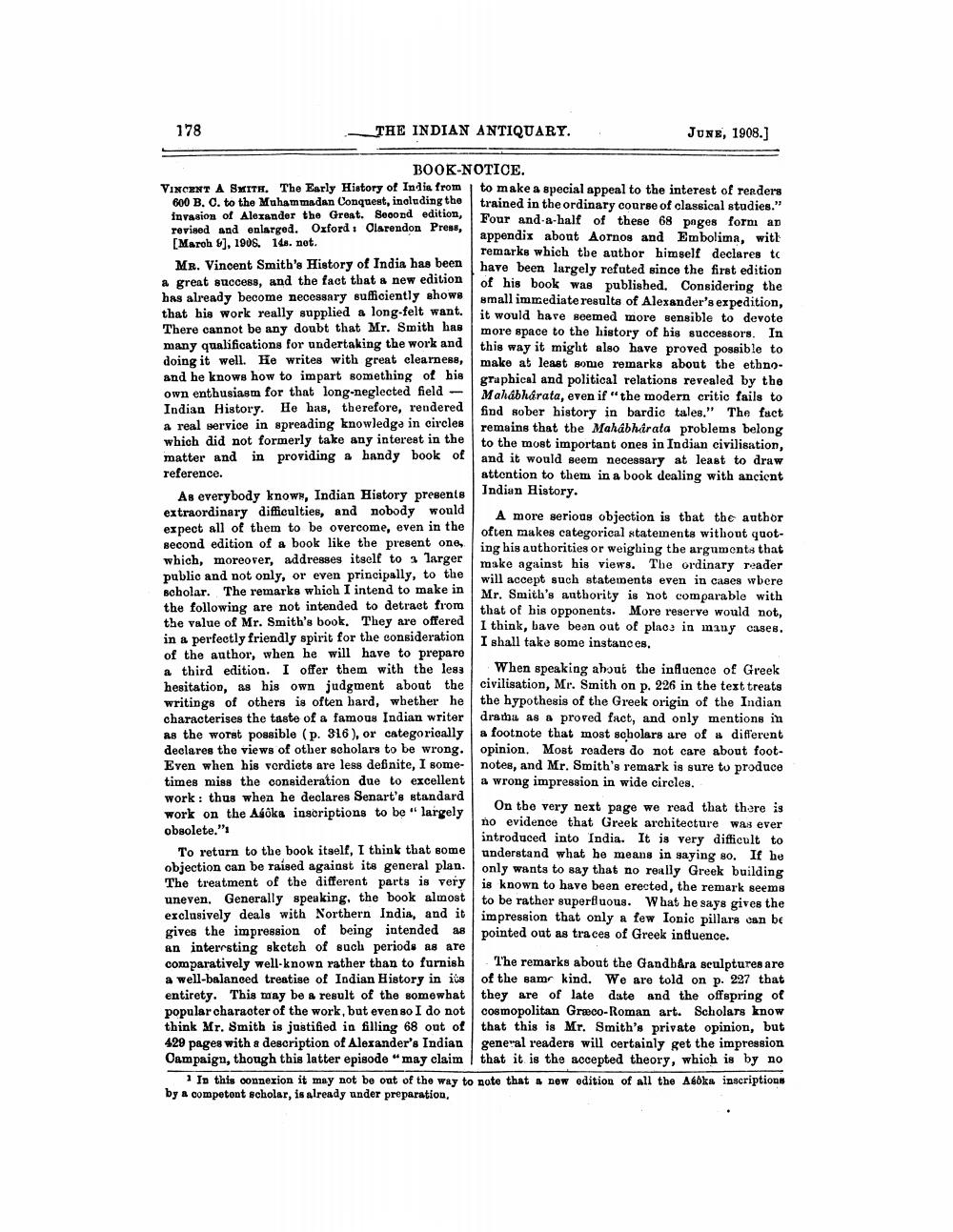________________
178
THE INDIAN ANTIQUARY.
JUNE, 1908.]
BOOK-NOTICE. VINCENT A SMITH. The Early History of India from to make a special appeal to the interest of readers 600 B. O, to the Muhammadan Conquest, including the trained in the ordinary course of classical studies." invasion of Alexander the Great. Second edition,
Four and-a-half of these 68 pages forn ap revised and enlarged. Oxford: Olarendon Press,
appendix about Aornog and Embolima, with [Maroh 9), 1906. 14. not.
remarks which tbe author himself declares to MR. Vincent Smith's History of India has been have been largely refuted since the first edition a great success, and the fact that a new edition
of his book was published. Considering the has already become necessary sufficiently shows
small immediate results of Alexander's expedition, that his work really supplied a long-felt want. lit would her
it would have seemed more sensible to devote There cannot be any doubt that Mr. Smith has
more space to the history of his successors. In many qualifications for undertaking the work and
this way it might also have proved possible to doing it well. He writes with great clearnese,
make at least some remarks about the ethnoand he knows how to impart something of his
graphical and political relations revealed by the own enthusiasm for that long-neglected field
Mahabharata, even if "the modern critic fails to Indian History. He has, therefore, rendered find sober history in bardio tales." The fact a real service in spreading knowledge in circies remains that the Mahabharata problems belong which did not formerly take any interest in the
to the most important ones in Indian civilisation, matter and in providing a handy book of
and it would seem necessary at least to draw reference.
attention to them in a book dealing with ancient As everybody knows, Indian History presents
Indian History. extraordinary difficulties, and nobody would
A more serious objection is that the author expect all of them to be overcome, even in the
often makes categorical statements without quotsecond edition of a book like the present one, ing his authorities or weighing the arguments that which, moreover, addresses itselt to larger make against his views. The ordinary reader publio and not only, or even principally, to the
will accept such statements even in cases wbere scholar. The remarks which I intend to make in
Mr. Smith's authority is not comparable with the following are not intended to detract from
that of his opponents. More reserve would not, the value of Mr. Smith's book. They are offered
I think, bave been out of place in many cases. in a perfectly friendly spirit for the consideration
I shall take some instances. of the author, when he will have to prepare a third edition. I offer them with the less When speaking about the influence of Greek hesitation, as his own judgment about the civilisation, Mr. Smith on p. 226 in the text treats writings of others is often hard, whether he the hypothesis of the Greek origin of the Indian characterises the taste of a famous Indian writer drama as a proved fact, and only mentions in as the worst possible (p. 316), or categorically a footnote that most scholars are of a different declares the views of other scholars to be wrong. opinion, Most readers do not care about footEven when his verdicts are less definite, I some-notes, and Mr. Smith's remark is sure to produce times miss the consideration due to excellent a wrong impression in wide circles. work : thus when he declares Senart's standard
On the very next page we read that there is work on the Aboka inscriptions to be " largely
no evidence that Greek architecture was ever obsolete.":
introduced into India. It is very difficult to To return to the book itself, I think that some
understand what he means in saying so. If he objection can be raised against its general plan. only wants to say that no really Greek building The treatment of the different parts is very is known to have been erected, the remark seems uneven. Generally speaking, the book almost
to be rather superfluous. What he says gives the exclusively deals with Northern India, and it
impression that only a few Ionic pillars can be gives the impression of being intended as
pointed out as traces of Greek intluence. an interrsting sketch of such periods as are comparatively well-known rather than to furnish The remarks about the Gandbara sculptures are a well-balanced treatise of Indian History in its of the samr kind. We are told on p. 227 that entirety. This may be a result of the somewhat they are of late date and the offspring of popular character of the work, but even so I do not Cosmopolitan Græco-Roman art. Scholars know think Mr. Smith is justified in filling 68 out of that this is Mr. Smith's private opinion, but 429 pages with a description of Alexander's Indian general readers will certainly get the impression Campaign, though this latter episode "may claim that it is the accepted theory, which is by no
In this connexion it may not be out of the way to note that now odítion of all the Aboka inscriptions by a competent scholar, is already under preparation,




